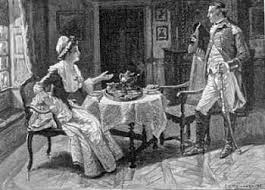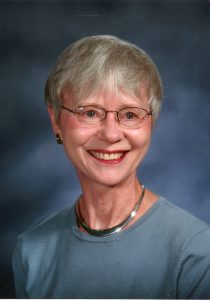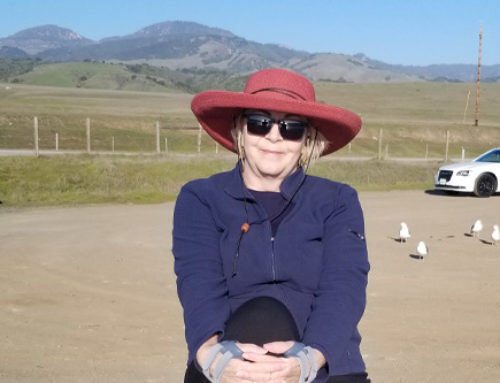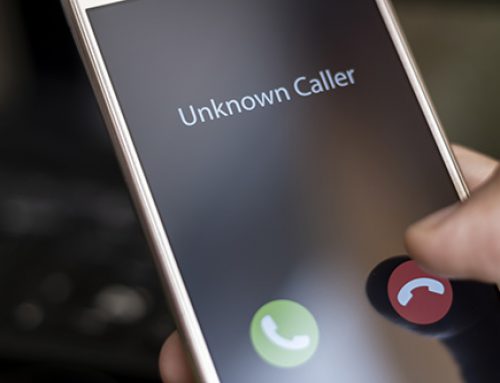Perhaps unwittingly, the Founding Fathers ushered in changes in the status of the Founding Mothers. The boycott was the most effective method of protest, devised by the various men’s meetings to combat the taxes being imposed by Great Britain on her American colonies.
 By 1765, all but the poorest of urban women were relieved of the onerous, time-consuming duties of spinning and weaving because they could buy cloth imported from the “Mother Country.” They also enjoyed imported china, furniture, tea and other non-perishable food items. Any visit to a restored colonial home attests to the prosperity of many Americans and the extent to which enjoyment of that prosperity depended on buying imports.
By 1765, all but the poorest of urban women were relieved of the onerous, time-consuming duties of spinning and weaving because they could buy cloth imported from the “Mother Country.” They also enjoyed imported china, furniture, tea and other non-perishable food items. Any visit to a restored colonial home attests to the prosperity of many Americans and the extent to which enjoyment of that prosperity depended on buying imports.
Men quickly surmised, as did one strategist at the Stamp Act Congress, “the greatest difficulty of all we have to encounter . . . is, to persuade our wives to give us their assistance, without which ‘tis impossible to succeed.” In short order, women became crucial participants in boycotting British goods.
It became acceptable for women to be seen in public protesting in a political cause. It became acceptable for women’s names to be printed in the newspaper as participating in the now patriotic, no longer demeaning, act of spinning and weaving cloth. Women were applauded by the men for organizing protest groups and signing their names to agreements to boycott British goods, including the highly valued import, tea. In time women applauded themselves for their importance in resisting “taxation without representation” and even published poems attesting to the importance of “the Daughters of Liberty.”
The Boston Evening Post conceded that women “Equally share in the honor of it,” as women’s importance to the revolutionary cause grew. The Founding Men overcame “the greatest difficulty” by elevating the status of the “Founding Women” to that of patriotic activists. Women formed organizations, collected money, sewed shirts for soldiers, ran their husbands’ businesses in their absence or after their deaths. They spied, carried messages, became camp followers nursing the sick and injured, doing the laundry and cooking, carrying water and on occasion, taking up arms when their husbands were killed.
When the Revolutionary War brought American independence it also ushered in a republican form of government. As Benjamin Rush declared in 1778, “Virtue, Virtue alone. . . is the basis of a republic.” But how were they to ensure the emergence of a virtuous ruling class? Virtuous citizens originated in the home.
Authors of the founding era proclaimed the importance of “Republican Motherhood.” Women were now to play a role essential to the welfare of the nation. One postwar young woman identified their task to “inspire her brothers, her husband, and her sons, with such a love of virtue, such just ideas of the true value of civil liberty. . . that future heroes and statesmen. . . shall exhaltingly declare it is to my mother I owe this elevation.” John Adams shared that when presented with an exemplary man, he would inquire about his mother.
But women could not fulfill this role without access to education. Academies for women sprang up as the need to educate girls became important. Men’s work had been demystified. Women had succeeded in roles previously closed to them. Women began to be more assertive in limiting the number of pregnancies. Women marrying after 1780 and particularly after 1800 had fewer pregnancies.
The American Revolution was not a social revolution. It did not bring independence from tyrannical husbands or even the desire for the political equality women began to seek decades later, but the “genie was out of the bottle” and the foundation was laid for future campaigns for women’s rights. A new cohort of women was being educated to become the leaders of the various reform movements that emerged in the second quarter of the nineteenth century.
 Joan Musbach taught American History in middle and high school for over 40 years. She earned a BA in History from the University of Kansas, an MAT from Northwestern University and has done post-graduate work in American History at Stanford and the University of Virginia. She has presented strategies for teaching American History at teacher workshops for the National Council for History Education and the National Endowment for the Humanities. In semi-retirement, she is Adjunct Professor of Education at Webster University and teaches courses for Oasis in St. Louis.
Joan Musbach taught American History in middle and high school for over 40 years. She earned a BA in History from the University of Kansas, an MAT from Northwestern University and has done post-graduate work in American History at Stanford and the University of Virginia. She has presented strategies for teaching American History at teacher workshops for the National Council for History Education and the National Endowment for the Humanities. In semi-retirement, she is Adjunct Professor of Education at Webster University and teaches courses for Oasis in St. Louis.
Learn more about “Women of the Founding Era,” in a two-session class, March 17 & 23, from 1 to 3 p.m., at the Oasis Center in Clayton.





